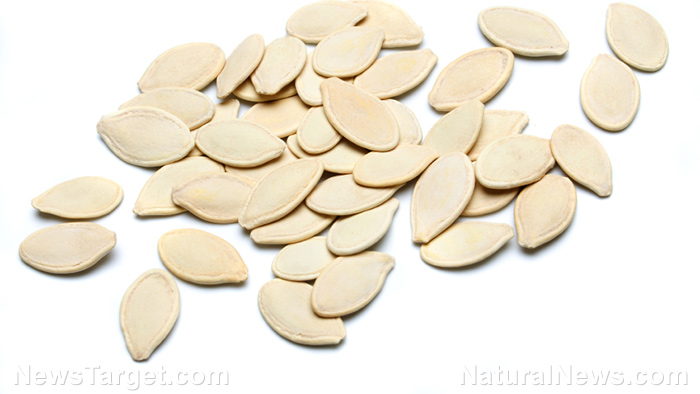Pumpkin seeds found to lower blood sugar levels
09/27/2019 / By Ralph Flores

The phrase “big things come in small packages” could very well be talking about pumpkin seeds. The flat, oval-shaped seeds are equal parts healthy and delicious, making them a great addition to soups, salads, and desserts. Researchers from the University of Nottingham in the U.K. revealed that these seeds can even help manage blood sugar levels in people with diabetes. The study, which they released in Critical Reviews in Food Science and Nutrition, identified compounds in pumpkin seeds that have the ability to lower blood sugar levels, namely: trigonelline (TRG), nicotinic acid (NA), and d-chiro-inositol (DCI).
For Gary Adams, a researcher from Nottingham’s School of Health Sciences and a co-author of the study, the findings highlight the potential of using pumpkin seeds – as well as pumpkins in general – to maintain healthy blood sugar levels.
“There are many different types of insulins available to treat diabetes, but there are still physiological consequences for such use,” he added. “Alternatives are, therefore, required and this includes herbal preparations as well as dietary plants in the form of Cucurbitaceae (pumpkin).”
The team, which also included experts from Abant Izzet Baysal University in Turkey, investigated whether bioactive ingredients in pumpkins are effective in maintaining blood sugar levels. They extracted the pulp and the seeds and looked at potential components with hypoglycemic properties.
They found that certain active ingredients – including polysaccharides, peptides and proteins – have potential blood sugar-lowering effects. In particular, they noted the following compounds:

- Trigonelline – a plant compound found in both pumpkin seeds and fenugreek. An earlier study published in Current Medicinal Chemistry revealed that trigonelline can improve B-cell regeneration, insulin secretion and glucose metabolism. In another study, researchers from Japan treated diabetic rats with trigonelline and found that it helped improve insulin levels while reducing liver triglycerides.
- Nicotinic acid (also known as vitamin B3 or niacin) – a B-vitamin that naturally occurs in food. It is primarily used for lowering “bad” low-density lipoprotein (LDL) cholesterol, as well as improving “good” high-density lipoprotein (HDL) cholesterol. This also gives the vitamin its heart-healthy property.
- D-chiro-inositol – a form of inositol derived from myo-inositol. Inositol is a carbohydrate known for its potential health benefits. One study in the International Journal of Endocrinology concluded that supplementing with a combination of myo- and d-chiro-inositol can benefit those with Type 2 diabetes, given their ability to improve glycemic control, or blood sugar regulation.
In sum, the researchers concluded that these compounds have potential hypoglycemic properties. (Related: Pumpkin seeds, mostly eaten during Halloween, contain an impressive array of vitamins and minerals that support heart health.)
Add pumpkin seeds to meals to reduce blood sugar levels
For those looking to make the most of pumpkin seeds’ hypoglycemic properties, adding them to meals is the best way to go. That’s according to researchers from Brazil, in a study published in Nutrition Research. In their research, the team conducted a randomized controlled trial, where they gave participants high-carbohydrate meals mixed with either flaxseeds or pumpkin seeds. Based on blood sugar measurements done after their meals, those who ate meals with pumpkin seeds had better glycemic control than those in the control group. Researchers also noted that consuming 65 g of pumpkin seed can improve blood sugar levels after mealtime.
How to include pumpkin seeds in your diets
Pumpkin seeds can be eaten in many ways. In terms of flavor, pumpkin seeds have a neutral taste, which can be enhanced by roasting them or adding some spices. Topping salads and soups with roasted pumpkin seeds adds a distinct nuttiness and ups their nutritional value. For those looking to add the seeds to their diet but don’t care for their taste, blending it with other ingredients into a smoothie is a good way to sneak them into meals.
Most grocery stores stock pumpkin seeds. In the U.S., pumpkin seeds become increasingly abundant around autumn – often a byproduct of carved pumpkins for Halloween.
Sources include:
Submit a correction >>
Tagged Under:
blood sugar, cardiovascular health, d-chiro-inositol, diabetes, disease treatments, fight diabetes, food cures, food is medicine, functional food, glucose, grocery cures, heart health, hypoglycemic, inositol, insulin, natural medicine, niacin, nicotinic acid, peptides, postprandial glycemia, prevention, pumpkin seeds, research, trigonelline, Type 2 Diabetes, vitamin B3
This article may contain statements that reflect the opinion of the author





















